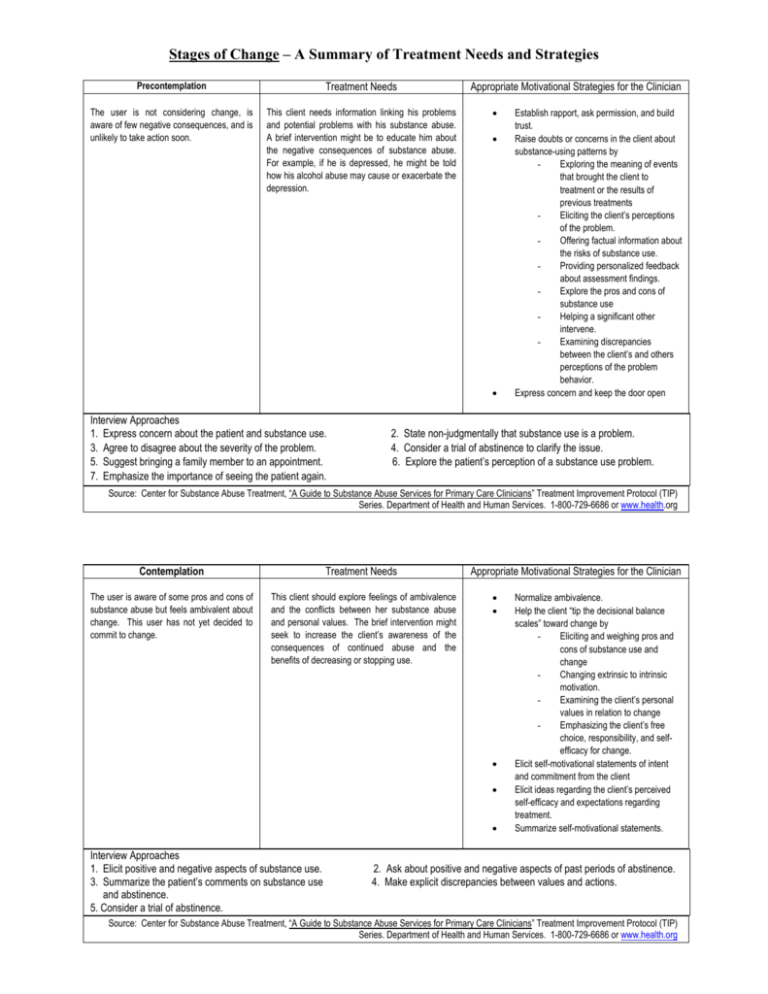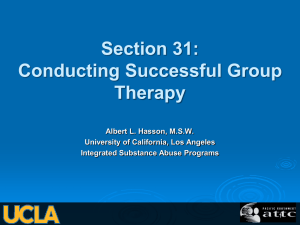Stages of Change – A Summary of Treatment Needs and Strategies
advertisement

Stages of Change – A Summary of Treatment Needs and Strategies Precontemplation Treatment Needs The user is not considering change, is aware of few negative consequences, and is unlikely to take action soon. This client needs information linking his problems and potential problems with his substance abuse. A brief intervention might be to educate him about the negative consequences of substance abuse. For example, if he is depressed, he might be told how his alcohol abuse may cause or exacerbate the depression. Appropriate Motivational Strategies for the Clinician • • • Interview Approaches 1. Express concern about the patient and substance use. 3. Agree to disagree about the severity of the problem. 5. Suggest bringing a family member to an appointment. 7. Emphasize the importance of seeing the patient again. Establish rapport, ask permission, and build trust. Raise doubts or concerns in the client about substance-using patterns by Exploring the meaning of events that brought the client to treatment or the results of previous treatments Eliciting the client’s perceptions of the problem. Offering factual information about the risks of substance use. Providing personalized feedback about assessment findings. Explore the pros and cons of substance use Helping a significant other intervene. Examining discrepancies between the client’s and others perceptions of the problem behavior. Express concern and keep the door open 2. State non-judgmentally that substance use is a problem. 4. Consider a trial of abstinence to clarify the issue. 6. Explore the patient’s perception of a substance use problem. Source: Center for Substance Abuse Treatment, “A Guide to Substance Abuse Services for Primary Care Clinicians” Treatment Improvement Protocol (TIP) Series. Department of Health and Human Services. 1-800-729-6686 or www.health.org Contemplation Treatment Needs The user is aware of some pros and cons of substance abuse but feels ambivalent about change. This user has not yet decided to commit to change. This client should explore feelings of ambivalence and the conflicts between her substance abuse and personal values. The brief intervention might seek to increase the client’s awareness of the consequences of continued abuse and the benefits of decreasing or stopping use. Appropriate Motivational Strategies for the Clinician • • • • • Interview Approaches 1. Elicit positive and negative aspects of substance use. 3. Summarize the patient’s comments on substance use and abstinence. 5. Consider a trial of abstinence. Normalize ambivalence. Help the client “tip the decisional balance scales” toward change by Eliciting and weighing pros and cons of substance use and change Changing extrinsic to intrinsic motivation. Examining the client’s personal values in relation to change Emphasizing the client’s free choice, responsibility, and selfefficacy for change. Elicit self-motivational statements of intent and commitment from the client Elicit ideas regarding the client’s perceived self-efficacy and expectations regarding treatment. Summarize self-motivational statements. 2. Ask about positive and negative aspects of past periods of abstinence. 4. Make explicit discrepancies between values and actions. Source: Center for Substance Abuse Treatment, “A Guide to Substance Abuse Services for Primary Care Clinicians” Treatment Improvement Protocol (TIP) Series. Department of Health and Human Services. 1-800-729-6686 or www.health.org Preparation Treatment Needs Appropriate Motivational Strategies for the Clinician This stage begins once the user has decided to change and begins to plan steps toward recovery. This client needs work on strengthening commitment. A brief intervention might give the client a list of options for treatment (e.g., inpatient treatment, outpatient treatment, 12-Step meetings) from which to choose, then help the client plan how to go about seeking the treatment that is best for him. • • • • • • • • • • Interview Approaches 1. Acknowledge the significance of the decision to seek treatment. 3. Affirm patient’s ability to successfully seek treatment. 5. Caution that the road ahead is tough but very important Clarify the client’s own goals and strategies for change. Offer a menu of options for change or treatment. With permission, offer expertise and advice. Negotiate a change-or treatment-plan and behavior contract. Consider and lower barriers to change. Help the client enlist social support Explore treatment expectancies and the client’s role. Elicit from the client what has worked in the past either for him or others who he knows. Assist the client to negotiate finances child care, work transportation, or other potential barriers. Have the client publicly announce plans to change. 2. Support self-efficacy 4. Help the patient decide on appropriate, achievable action 6. Explain that relapse should not disrupt the patient-clinician relationship. Source: Center for Substance Abuse Treatment, “A Guide to Substance Abuse Services for Primary Care Clinicians” Treatment Improvement Protocol (TIP) Series. Department of Health and Human Services. 1-800-729-6686 or www.health.org Action Treatment Needs The user tries new behaviors, but these are not yet stable. This stage involves the first active steps toward change. This client requires help executing an action plan and may have to work on skills to maintain sobriety. The clinician should acknowledge the client’s feelings and experiences as a normal part of recovery. Brief interventions could be applied throughout this stage to prevent relapse. Appropriate Motivational Strategies for the Clinician • • • • • • Interview Approaches 1. Be a source of encouragement and support 3. Reinforce the importance of remaining in recovery. Engage the client in treatment and reinforce the importance of remaining in recovery. Support a realistic view of change through small steps. Acknowledge difficulties for the client in early stages of change. Help the client identify high-risk situations through a functional analysis and develop appropriate coping strategies to over come these. Assist the clients in finding new reinforcers of positive change. Help the client assess whether she has strong family and social support 2. Acknowledge the uncomfortable aspects of withdrawal. Source: Center for Substance Abuse Treatment, “A Guide to Substance Abuse Services for Primary Care Clinicians” Treatment Improvement Protocol (TIP) Series. Department of Health and Human Services. 1-800-729-6686 or www.health.org The Stages of Change (cont’d.) – A Summary of Treatment Needs and Strategies Maintenance The user establishes new behaviors on a long term basis. Treatment Needs This client needs help with relapse prevention. A brief intervention could reassure, evaluate present actions, and redefine long-term sobriety maintenance plans. Appropriate Motivational Strategies for the Clinician • • • • • • • Interview Approaches 1. Anticipate difficulties as a means of relapse prevention. 3. Support the patient’s resolve. Help the client identify and sample drug-free sources of pleasure (ie, new reinforcers). Support lifestyles changes. Affirm the client’s resolve and self-efficacy Help the client practice and use new coping strategies to avoid a return to use. Maintain supportive contact (e.g., explain to the client that you are available to talk between sessions). Develop a “fire escape” plan if the client resumes substance use. Review long-term goals with the client. 2. Recognize the patient’s struggle 4. Reiterate the relapse should not disrupt the medical care relationship. Source: Center for Substance Abuse Treatment, “A Guide to Substance Abuse Services for Primary Care Clinicians” Treatment Improvement Protocol (TIP) Series. Department of Health and Human Services. 1-800-729-6686 or www.health.org Relapse The client has experienced a recurrence of symptoms and must now cope with consequences and decide what to do next. Appropriate Motivational Strategies for the Clinician • • • • Interview Approaches 1. Explore what can be learned from the relapse. 3. Emphasize positive aspect of the effort to seek care. Help the client reenter the change cycle and commend any willingness to reconsider positive change. Explore the meaning and reality of the recurrence as a learning opportunity Assist the client in finding alternative coping strategies. Maintain supportive contact. 2. Express concern and even disappointment about the relapse 4. Support patient’s self-efficacy so that recovery seems achievable Source: Center for Substance Abuse Treatment, “A Guide to Substance Abuse Services for Primary Care Clinicians” Treatment Improvement Protocol (TIP) Series. Department of Health and Human Services. 1-800-729-6686 or www.health.org






